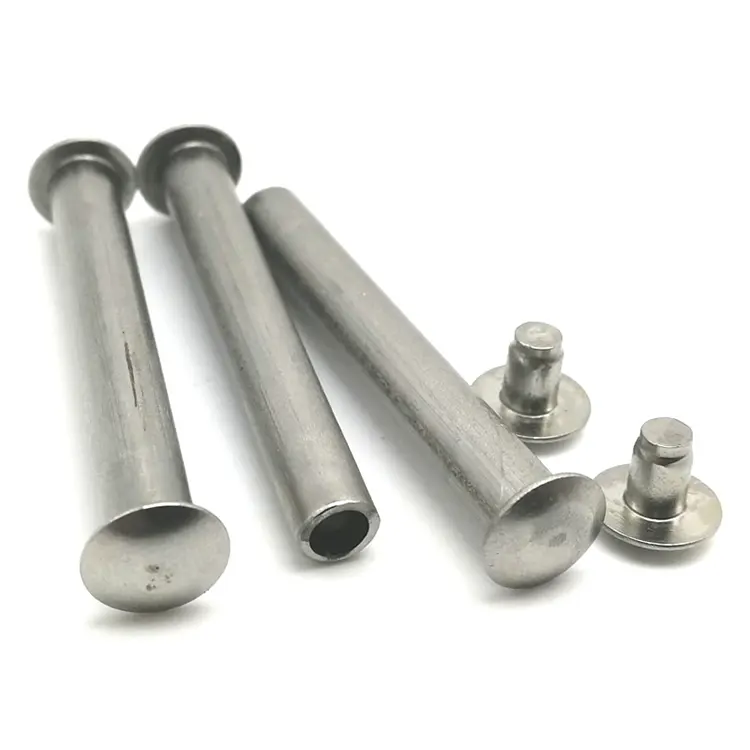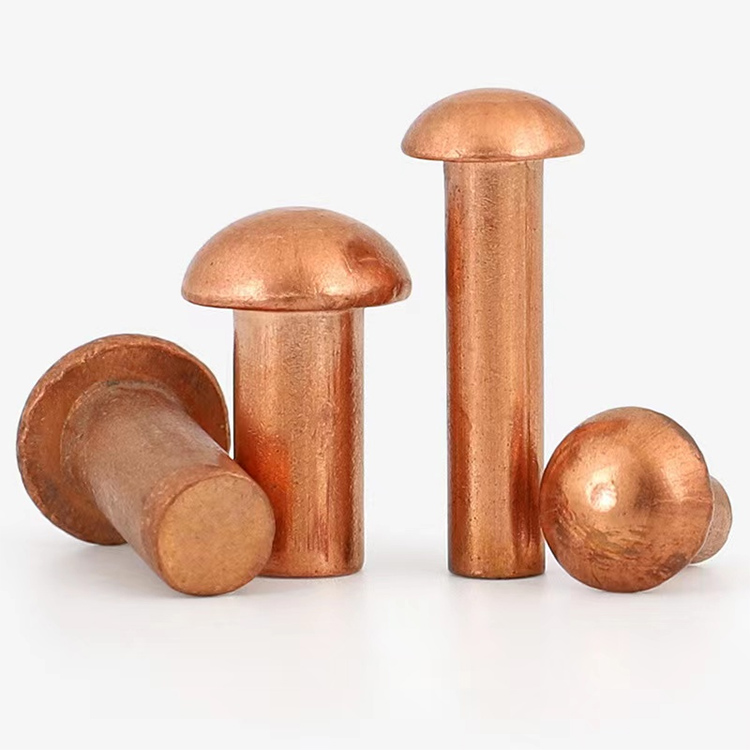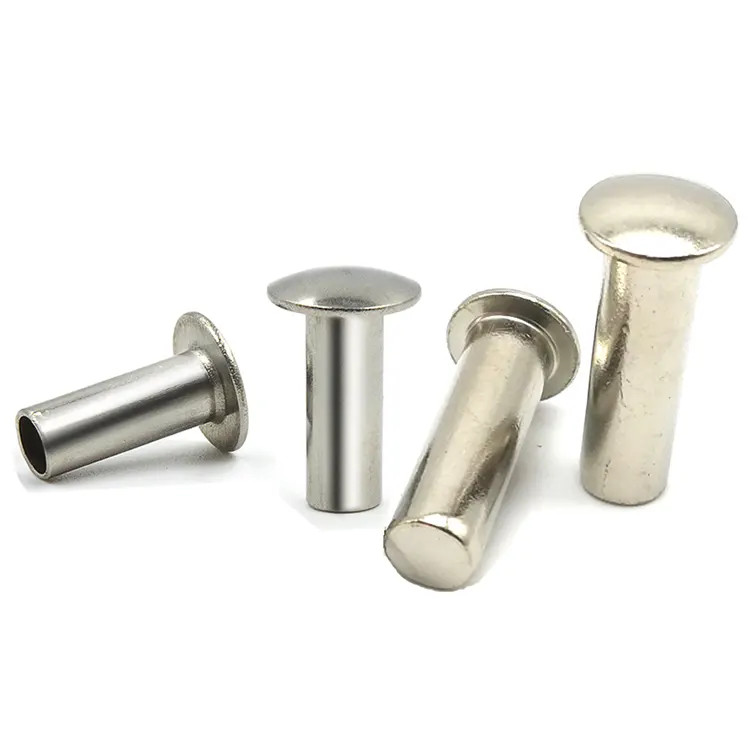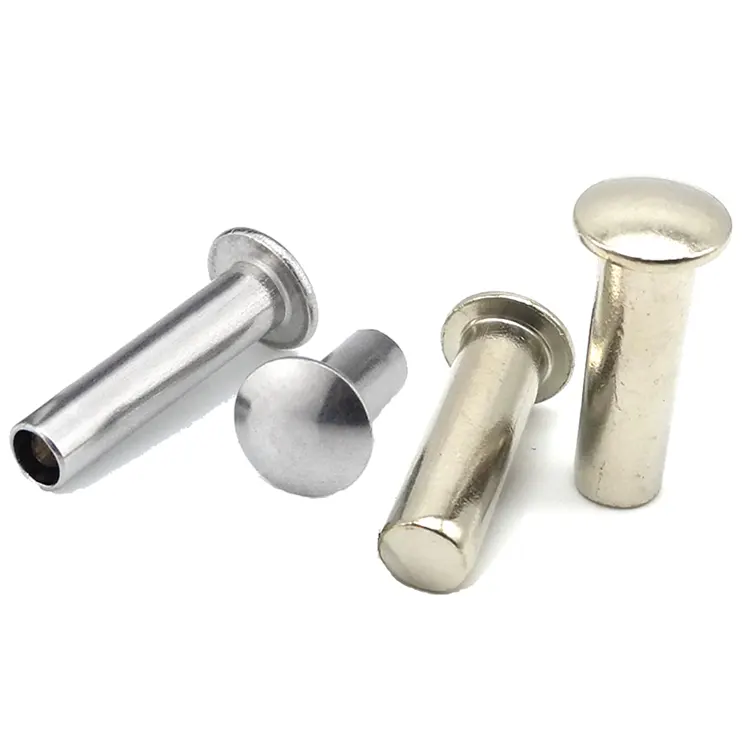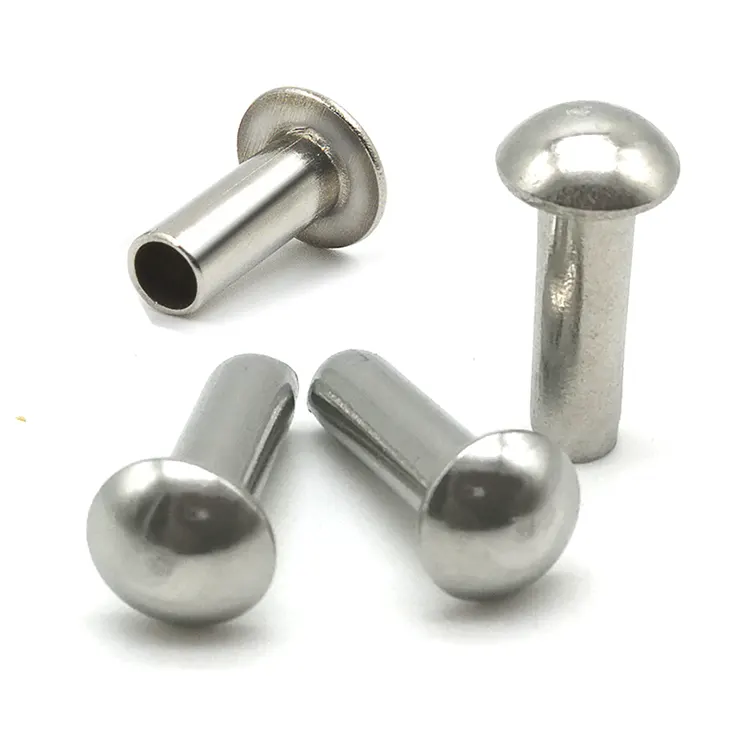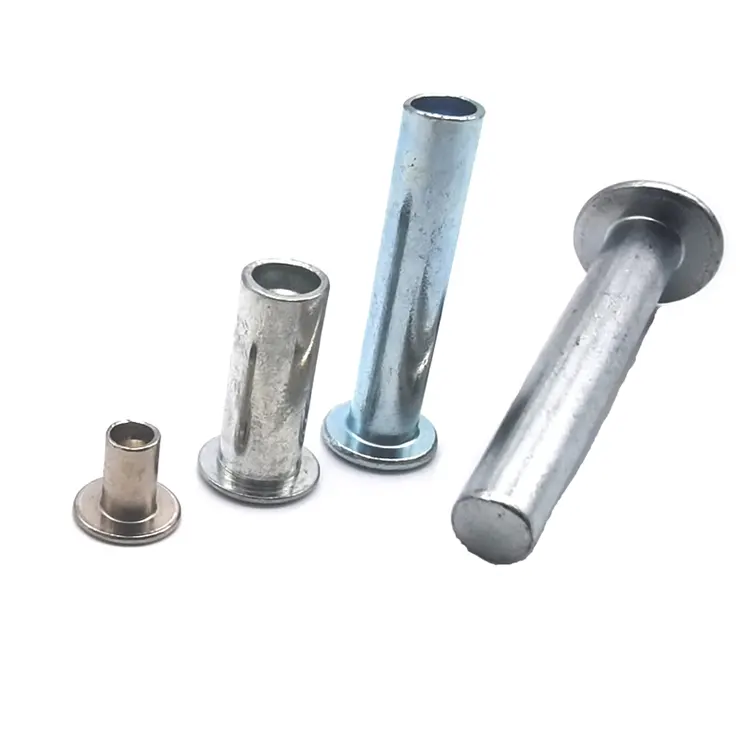Rivets
As one of professional manufacturer in China, Notin would like to provide you Rivets. And we will offer you the best after-sale service and timely delivery.
What is a rivet?
A rivet is a permanent mechanical fastener used to join two or more materials. Rivets work by inserting a metal pin into an aligned hole and deforming the end, creating a strong, secure, and durable connection. Unlike temporary fasteners like screws, rivets do not rely on threads, but instead form a permanent connection, making them ideal for applications requiring high strength, durability, and vibration resistance.
Classification of Rivets
Rivets are typically categorized by head shape, degree of hollowness, or material.
Based on head shape, rivets can be classified as flat head rivets, round head rivets, countersunk head rivets, mushroom head rivets, universal head rivets, truss head rivets, etc.

Based on degree of hollowness, rivets can be classified as solid rivets, semi-tubular rivets, or full tubular rivets.
Based on material, rivets can be classified as brass rivets, stainless steel rivets, steel rivets, aluminum rivets, copper rivets, etc.
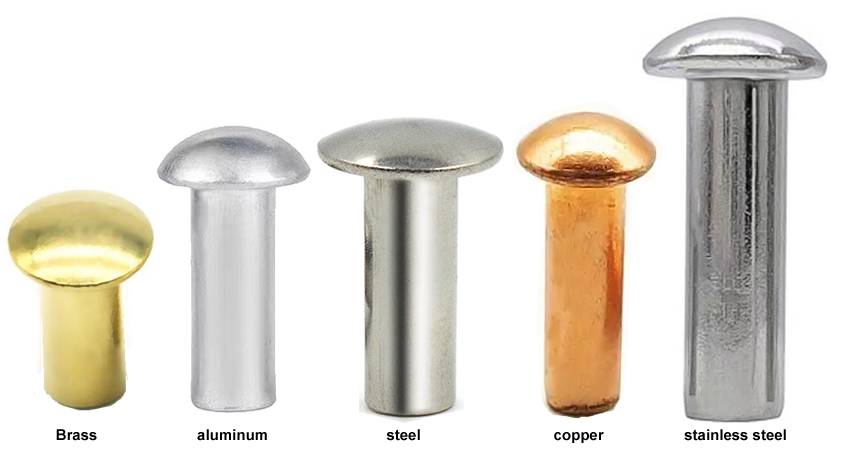
What surface finishes are available for rivets?
Rivet surfaces are typically treated with rust-proofing treatments, primarily electroplating, including zinc plating, nickel plating, chrome plating, tin plating, gold plating, and silver plating. Electroplating is a common rust-proofing method for rivets. It applies a layer of plating to the rivet surface through physical or chemical methods. The plating effectively prevents corrosion and rust, while also providing a certain aesthetic effect.
Another special surface treatment method is head coating. Head coating is performed after the rivet is electroplated. This allows for a variety of colors on the rivet head, achieving an aesthetically pleasing finish.
Aluminum rivets cannot be electroplated, but they can be anodized. Anodizing also allows for a variety of color options, but the unit price is higher than electroplating.
Rust-proofing the rivet surface is crucial, effectively extending the rivet's service life and ensuring a secure connection. Different rust-proofing methods are suitable for different environments and applications, so the choice should be tailored to the specific situation.
- View as
Rivets en acier
Les rivets en acier au carbone sont une fixation mécanique courante utilisée dans une grande variété de produits industriels et quotidiens. Leur fonction principale est de connecter en toute sécurité deux ou plusieurs composants ensemble, créant ainsi une structure stable. Les rivets en acier au carbone sont populaires en raison de leur résistance, de leur durabilité et de leur rentabilité. Nuote Metals fabrique des rivets en acier au carbone depuis plus d'une décennie. Situé à Dongguan, en Chine, connue sous le nom de « l'usine du monde », nous accueillons les visiteurs du monde entier.
En savoir plusenvoyer une demandeRivets à tête cylindrique en acier
Les rivets à tête cylindrique en acier sont des fixations industrielles courantes utilisées dans un large éventail d'applications, notamment l'automobile, l'aviation et la construction. Nuote Metals est spécialisé dans la production de rivets à tête cylindrique en acier, vendus dans le monde entier. Nous proposons une large gamme de rivets fabriqués dans divers matériaux, notamment le laiton, l'acier inoxydable, l'aluminium et le cuivre. Nous pouvons également personnaliser nos produits avec divers traitements de surface, tels que la galvanoplastie, le décapage et l'anodisation, pour répondre aux exigences des clients.
En savoir plusenvoyer une demandeRivets à tête champignon en acier
Les rivets à tête champignon en acier, également appelés rivets à tête bombée, sont largement utilisés dans les applications industrielles. Leur forme unique en tête de champignon et leur construction en acier offrent une connexion sûre et fiable pour une variété de structures. Nuote Metals est un spécialiste des rivets à tête champignon en acier. Nos rivets sont vendus dans le monde entier et ont gagné la reconnaissance des clients nationaux et internationaux. Nous apprécions vos demandes et l’opportunité de vous servir.
En savoir plusenvoyer une demandeRivets à tête plate en acier
Les rivets à tête plate en acier relient solidement les composants par déformation ou ajustement serré, garantissant qu'ils restent inséparables et adaptés aux applications soumises à des charges générales. Ils peuvent également être finis avec du nickel, du zinc blanc, du zinc bleu, du zinc noir, du zinc coloré, du cuivre ou du chrome pour s'adapter à divers environnements et exigences esthétiques. Nuote Metals est spécialisé dans la production de rivets à tête plate en acier, expédiés dans le monde entier. Les commandes personnalisées sont également les bienvenues.
En savoir plusenvoyer une demandeRivets à tête fraisée en acier
Les rivets à tête fraisée en acier sont une fixation couramment utilisée pour relier deux ou plusieurs pièces. Ils sont fixés aux pièces par martelage ou force mécanique, créant ainsi une connexion sécurisée. Nuote Metals est un spécialiste de la production de rivets à tête fraisée en acier, situé à Dongguan, en Chine, une ville à l'industrie florissante. Nos rivets présentent une surface lisse et sans bavures, un placage impeccable et des joints sans fissures. Nous acceptons les demandes de renseignements et les commandes.
En savoir plusenvoyer une demandeRivets à tête ronde en acier inoxydable
Les rivets à tête ronde offrent une excellente résistance à la corrosion. Cela est particulièrement vrai pour les rivets à tête ronde en acier inoxydable 304, qui sont fabriqués en acier inoxydable 304, un matériau réputé pour son excellente résistance à la corrosion, sa bonne ouvrabilité et sa finition esthétique. L'acier inoxydable 304 résiste aux attaques d'une large gamme de produits chimiques, ce qui le rend idéal pour une utilisation dans des environnements humides et corrosifs. En conséquence, les rivets à tête ronde en acier inoxydable 304 offrent une durée de vie plus longue en extérieur ou dans des environnements humides, sont moins sujets à la rouille et offrent de faibles coûts d'entretien.
En savoir plusenvoyer une demandeWhat are the advantages of rivets over other fasteners?
1. Ease of Installation
Rivets are fast to install, and even fully automated for high-volume applications, resulting in a simple and efficient operation process.
2. Connection Reliability
The riveting process is standardized, with strict quality control, resulting in highly stable connections. Visual inspection allows for quick verification of connection quality.
3. Vibration and Impact Resistance
Rivets connect through deformation or interference fit, providing strong clamping force and excellent vibration resistance, capable of withstanding vibration and shock.
4. Low Cost
Rivets are easy to install and can be fully automated, saving significant labor costs.
What are the advantages and disadvantages of rivets made of different materials?
Aluminum Rivets
Advantages: Lightweight, reduces overall product weight, low cost, suitable for general civilian applications.
Disadvantages: Low tensile and shear strength, unsuitable for high-strength workpieces, prone to electrochemical corrosion when in contact with metals such as stainless steel.
Stainless Steel Rivets
Advantages: Strong corrosion resistance, high hardness, suitable for high-strength workpieces (such as marine equipment)
Disadvantages: Higher cost, typically more expensive than aluminum rivets of the same specification.
Brass and Copper Rivets
Advantages: Excellent conductivity (such as connecting electronic components), good corrosion resistance.
Disadvantages: Higher cost, more difficult to process.
Steel Rivets
Advantages: High hardness, high connection reliability, and wide applicability.
Disadvantages: Compared to other materials, iron rivets are more prone to rusting.
What are the main applications of rivets?
Rivets have a wide range of uses, from small items like a pair of scissors to large items like airplanes and ships, as well as in high-precision medical applications.
Industrial Manufacturing
Rivets are used in a wide variety of industrial fields, wherever there is a need to connect two or more materials.
Electronics
Rivets secure heat sinks and chips, providing both vibration damping and noise reduction, and are widely used in the cooling systems of electronic products such as computers and mobile phones.
Automotive
Rivets are widely used to connect components of automobile bodies and chassis, such as doors and hoods. Their lightweight and corrosion-resistant properties make them an indispensable joining method in automotive manufacturing.
Aerospace
In aircraft manufacturing, rivets are used to connect different fuselage components, such as wings and tailplanes. Millions of rivets create high-strength, corrosion-resistant joints. Aluminum and titanium alloy rivets are often used to connect components of corresponding materials, ensuring stability in extreme environments.
Rivets are used everywhere. The above examples only represent a small number of their applications. We see rivets everywhere in our daily lives, such as on scissors, folding beds, and strollers etc. Rivets can be customized to different sizes and materials depending on the application.
Nuote Metals has specialized in the rivet industry for over a decade. Our factory is located in Dongguan, a city known as the "World Factory," a city with a developed industry and convenient transportation. This allows us to respond quickly when acquiring raw materials and supporting surface treatments, meeting our customers' needs for quick access to samples and bulk orders. We produce 10 million rivets daily and have molds of various specifications, allowing us to produce rivets as small as 0.8mm and as large as 10mm. We welcome your inquiries and visits.

